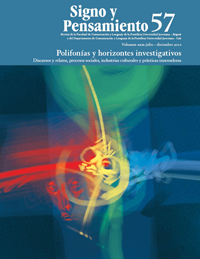Abstract
As Victoria Camps puts it: “[to take] information as a reflection of reality is a myth. What it really deals with is with the disclosure or exposure of the things that happen… and, at the same time, shaping that which in fact happens”. Yet, the act of giving reality a “format” is not an aseptic exercise, since it implies omissions, exclusions, and silences that end up presenting half-truths, as was the case with the way two local newspapers covered Universidad del Cauca’s conflict in 2007, fact which raises questions as to the social function of mass media in the construction of citizenship skills and the strengthening of democracy.
Balandier, G. (1994), El poder en escenas, Barcelona, Paidós.
Bonilla Vélez, J. I. (2002a), “Periodismo, guerra y paz”, en Signo y Pensamiento, vol. XXI, núm. 40, Javegraf.
— (2002b), “Apuntes sobre medios de comunicación, esfera pública y democracia”, en Comunicación para construir lo público, Bogotá, Convenio Andrés Bello.
Camps, V. (1996), El malestar de la vida pública, Barcelona, Grijalbo.
Cuervo, L. M. (1996), “Ciudad y complejidad: la magnitud del reto”, en Pensar la ciudad, Bogotá, Tercer Mundo.
Ferry, J.-M. (1992), “Las transformaciones de la publicidad política”, en El nuevo espacio público, Barcelona, Gedisa.
Fuenzalida, V. (1999), “Géneros televisivos y cultura del protagonismo”, en Sunkel, G. (coord.), El consumo cultural en América Latina, Bogotá, Convenio Andrés Bello.
Garretón, M. A. (1995), “Democracia ciudadana y medios de comunicación”, en Los medios, nuevas plazas para la democracia, Lima, Calandria.
López de la Roche, F. (2002), Periodismo y movimientos sociales: entre la estigmatización y el reconocimiento, Bogotá, Politécnico Grancolombiano.
Maigret, É. (2005), Sociología de la comunicación y de los medios, Bogotá, Fondo de Cultura Económica.
Martín-Barbero, J. (1996), “La ciudad, una institución imaginaria”, en Pensar la ciudad, Bogotá, Tercer Mundo.
— (2003), Oficio de cartógrafo. Travesías latinoamericanas de la comunicación en la cultura, Bogotá, Fondo de Cultura Económica.
Mayorga, A. J. y Leon Pino, C. (2007), La noticia en la prensa nacional ¿narración discursiva verosímil o hecho verdadero? Una propuesta teórico-crítica acerca del discurso mediático [en línea], disponible en: http://web.upla.cl/revistafaro/03_estudios/pdf/05_estudios_mayorga. pdf, recuperado: 20 de septiembre de 2005.
PNUD (2003), El conflicto, callejón con salida. Informe nacional de desarrollo humano para Colombia-2003, Bogotá, Panamericana.
Rey, G. (2004), “El periodismo en tiempos difíciles”, en Proyecto Antonio Nariño. Calidad informativa y cubrimiento del conflicto, Bogotá, CEREC.
— (1996), “La espalda del vecino. Responsabilidad social de los medios de comunicación”, en Desde las dos orillas, Bogotá, Ministerio de Comunicaciones, ImpreAndes.
Rey, G. [dir] et. al. (2004), Calidad informativa y cubrimiento del conflicto, Bogotá, Proyecto Antonio Nariño.
Rincón, O. y Ruiz, M. (2002), “Más allá de la libertad. Informar en medio del conflicto”, en Signo y Pensamiento, vol. XXI, núm. 40, Javegraf.
Serna, A. y Useche, O. (2004), “Ciudad, ciudadanía y cultura”, Radio: un análisis, 88.5 fm, Bogotá.
Wimmer, R. y Dominick, J. (2001), Introducción a la investigación de medios masivos de comunicación, México, Thomson.
Wolf, M. (1991), La investigación de la comunicación de masas, Barcelona, Paidós.
This journal is registered under a Creative Commons Attribution 4.0 International Public License. Thus, this work may be reproduced, distributed, and publicly shared in digital format, as long as the names of the authors and Pontificia Universidad Javeriana are acknowledged. Others are allowed to quote, adapt, transform, auto-archive, republish, and create based on this material, for any purpose (even commercial ones), provided the authorship is duly acknowledged, a link to the original work is provided, and it is specified if changes have been made. Pontificia Universidad Javeriana does not hold the rights of published works and the authors are solely responsible for the contents of their works; they keep the moral, intellectual, privacy, and publicity rights.
Approving the intervention of the work (review, copy-editing, translation, layout) and the following outreach, are granted through an use license and not through an assignment of rights. This means the journal and Pontificia Universidad Javeriana cannot be held responsible for any ethical malpractice by the authors. As a consequence of the protection granted by the use license, the journal is not required to publish recantations or modify information already published, unless the errata stems from the editorial management process. Publishing contents in this journal does not generate royalties for contributors.


